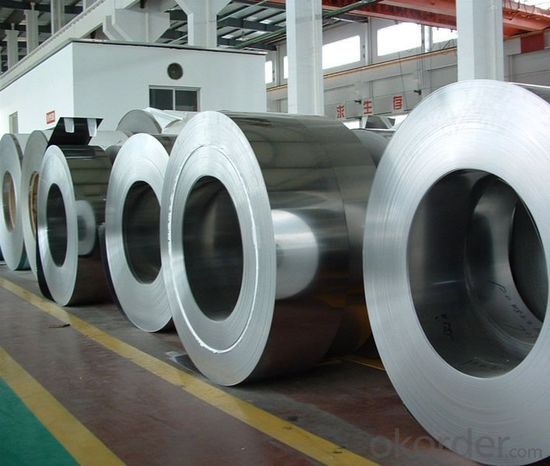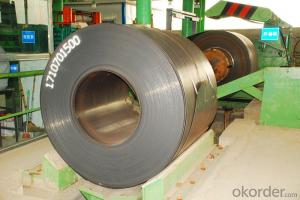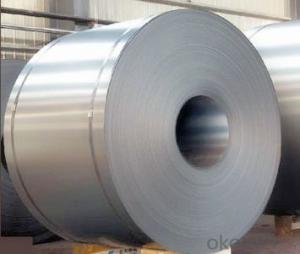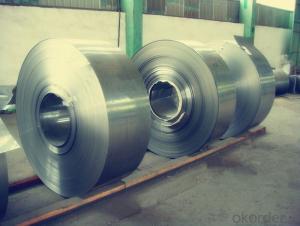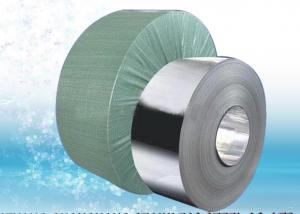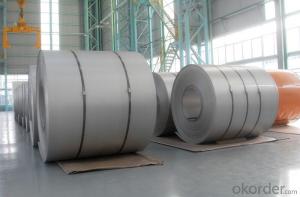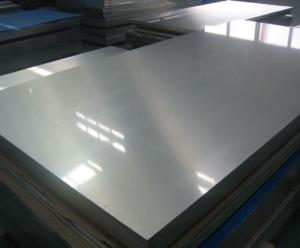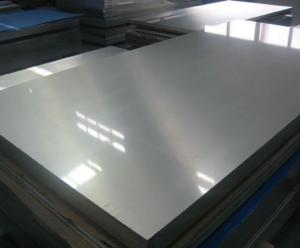Hot Rolled Stainless Steel Coil 201
- Loading Port:
- Qingdao
- Payment Terms:
- TT OR LC
- Min Order Qty:
- -
- Supply Capability:
- 5000 m.t./month
OKorder Service Pledge
OKorder Financial Service
You Might Also Like
Hot Rolled Stainless Steel Coil 201
Stainless steel is a production which not easy rust,acid resistance and corrosion resistance,so it is widely
used in light industry,heavy industry,daily necessities and the decoration industry.my company long-term
supply stainless steel porducts including:stainless steel sheet,stainless steel coil and stainless steel tube.
Grade: | 200 Series | Standard: | JIS,AISI,ASTM,GB,DIN | Thickness: | 2.5/3.0/4.0mm |
Width: | 485/510/550/610/1010/1240mm | Place of Origin: | Shanghai China (Mainland) | Brand Name: | CNBM |
Model Number: | 201 | Technique: | Hot Rolled | Application: | Industrial tubes/kitchen/bath |
Certification: | ISO | THK: | 2.5/3.0/4.0mm | Face: | No.1 |
Usage: | tubes/kitchen/bath | Origin: | CHINA | ||
Hot Stainless Steel Coil 201 grade, Chemical Composition(WT%)
(C):≤0.15, (Si):≤0.75, (Mn):5.5~7.50, (Cr):16.0~18.0, (N):≤0.25, (Ni):3.50~5.50, (P):≤0.060, (S):≤0.030
Hot Rolled Stainless Steel Coil 201 Grade
Strength Of Extension:100,000 To 180,000 Psi;
Yield Strength:50,000 To 150,000 Psi
Elongation :55 To 60%;
Modulus Of Elasticity:29,000,000 Psi;
Density :.280lbs/Cubic Inch(7.93g/Cm3)
- Q: Are stainless steel strips resistant to pitting?
- Yes, stainless steel strips are resistant to pitting.
- Q: Are stainless steel strips suitable for elevator doors?
- Yes, stainless steel strips are suitable for elevator doors. Stainless steel is a durable and corrosion-resistant material that is widely used in various applications, including elevator doors. Its strength and resistance to wear make it an ideal choice for elevator doors, as they are subject to heavy usage and constant contact with passengers. Additionally, stainless steel has a sleek and modern appearance, which can enhance the overall aesthetic of the elevator and provide a professional and sophisticated look. Overall, stainless steel strips offer the necessary durability, functionality, and visual appeal required for elevator doors.
- Q: Can stainless steel strips be used for kitchen appliances?
- Yes, stainless steel strips can be used for kitchen appliances. Stainless steel is a popular choice for kitchen appliances due to its durability, corrosion resistance, and sleek appearance. It provides a hygienic surface that is easy to clean and maintain. Stainless steel strips can be used to cover and protect various parts of kitchen appliances such as refrigerator doors, dishwasher panels, oven fronts, and range hoods. Additionally, stainless steel strips can be customized in terms of thickness, width, and finish to meet specific design requirements. Overall, stainless steel strips are a versatile and practical option for enhancing the aesthetics and functionality of kitchen appliances.
- Q: Can stainless steel strips be used in the production of oil and gas pipelines?
- Yes, stainless steel strips can be used in the production of oil and gas pipelines. Stainless steel is highly resistant to corrosion and can withstand extreme temperatures and pressures, making it a suitable material for pipelines in the oil and gas industry.
- Q: What industries commonly use stainless steel strips?
- Stainless steel strips are commonly used in various industries such as automotive, aerospace, construction, food processing, pharmaceutical, and manufacturing.
- Q: What are the common industry standards for stainless steel strips?
- The stainless steel industry adheres to different standards for stainless steel strips depending on the specific application and requirements. Numerous recognized standards are commonly followed by manufacturers and users in the industry. The American Society for Testing and Materials (ASTM) standard, in particular, is widely referenced. ASTM A666/A666M outlines the standard specification for annealed or cold-worked austenitic stainless steel strips. This specification includes details on the chemical composition, mechanical properties, and dimensional tolerances of these materials. Furthermore, the International Organization for Standardization (ISO) has developed multiple standards related to stainless steel strips. ISO 9445 specifies tolerances on dimensions and form for continuously cold-rolled stainless steel narrow strips, while ISO 9444 provides general requirements for preparing steel substrates before applying paints and related products. In Europe, the European Committee for Standardization (CEN) has established the EN standards for stainless steel strips. EN 10151 outlines the technical delivery conditions for cold-rolled stainless steel strips used for springs, while EN 10088-2 covers the technical delivery conditions for stainless steel strips used for general purposes. In addition to these widely recognized standards, certain sectors may follow industry or application-specific standards. These standards may include additional requirements or specifications based on the intended use of stainless steel strips, such as in the automotive, construction, or medical industries. It is crucial for manufacturers and users to be aware of the relevant industry standards and ensure compliance with them. This ensures the quality, performance, and compatibility of stainless steel strips in their specific applications.
- Q: How do you prevent rusting of stainless steel strips?
- To prevent rusting of stainless steel strips, it is important to keep them clean and dry. Regularly cleaning with mild soap and water, followed by thorough drying, helps remove any contaminants and moisture that can promote rust formation. Additionally, applying a thin coat of mineral oil or a specialized stainless steel cleaner can provide a protective barrier against rust.
- Q: What are the common uses of stainless steel strips in the semiconductor industry?
- Due to their unique characteristics and properties, stainless steel strips find a multitude of applications in the semiconductor industry. Some of the key uses are as follows: 1. Semiconductor fabrication involves the use of stainless steel strips as etching masks. These strips possess resistance against different chemical etchants and provide excellent corrosion resistance. Consequently, they are perfect for safeguarding specific areas of the semiconductor surface during the etching process. 2. Throughout the manufacturing process, stainless steel strips are employed for handling delicate silicon wafers. By offering a clean and contamination-free surface, the strips prevent any harm or contamination that could compromise the quality of the wafers. 3. In the construction of cleanrooms within the semiconductor industry, stainless steel strips are commonly utilized. The preference for these strips stems from their high resistance to corrosion, durability, and ability to withstand the harsh cleaning chemicals used in cleanroom maintenance. 4. To prevent damage to sensitive semiconductor components caused by electrostatic discharge (ESD), stainless steel strips function as grounding strips or ESD protection strips. These strips dissipate any static charges, thereby safeguarding the semiconductor devices during the assembly and testing processes. 5. Stainless steel strips are employed in the creation of heat exchangers that regulate temperature during different semiconductor manufacturing processes. The strips' exceptional thermal conductivity and corrosion resistance enable efficient heat transfer while maintaining a clean and sterile environment. 6. The surface mount technology (SMT) process involves the direct mounting of electronic components onto the surface of a printed circuit board. In this process, stainless steel strips serve as solder stencils, enabling the precise application of solder paste onto the board and ensuring accurate component placement during assembly. Overall, stainless steel strips are highly valued in the semiconductor industry due to their corrosion resistance, cleanliness, durability, and ability to withstand extreme conditions. As a result, they play an indispensable role in various stages of semiconductor manufacturing.
- Q: Can stainless steel strips be used in water heaters?
- Yes, stainless steel strips can be used in water heaters. Stainless steel is a corrosion-resistant material that can withstand high temperatures and is commonly used in water heater components, including heating elements, tanks, and pipes, due to its durability and resistance to rust and scaling.
- Q: How do stainless steel strips handle exposure to sulfuric acid?
- Stainless steel strips possess outstanding corrosion resistance properties, rendering them suitable for a vast array of applications. When confronting sulfuric acid, stainless steel strips commonly exhibit favorable performance, contingent upon the acid's concentration and temperature. Stainless steel comprises a substantial quantity of chromium, which generates a protective layer on the surface upon exposure to oxygen. This inactive layer acts as a shield against corrosive elements, including sulfuric acid. Nevertheless, the effectiveness of this layer may be compromised under specific circumstances. In diluted sulfuric acid solutions, stainless steel strips exhibit commendable resistance. The inactive layer remains intact, safeguarding the steel against corrosion. However, in scenarios involving higher concentrations or elevated temperatures, the inactive layer may become vulnerable to attack. Under such circumstances, it is advisable to opt for stainless steel grades with increased chromium and nickel content, such as 316 or 317. These alloys offer enhanced resistance to sulfuric acid, even in high concentrations and temperatures. Furthermore, the addition of molybdenum to the stainless steel composition can further augment its resistance to sulfuric acid. It is important to bear in mind that prolonged exposure to sulfuric acid can eventually result in corrosion, even in the most resistant stainless steel grades. Hence, regular inspections and maintenance play a crucial role in ensuring the durability of stainless steel strips within sulfuric acid environments. In conclusion, stainless steel strips generally exhibit satisfactory performance when exposed to sulfuric acid, particularly in diluted solutions. Nonetheless, for higher concentrations and temperatures, it is recommended to select the appropriate stainless steel grade with greater chromium, nickel, and possibly molybdenum content to guarantee optimal corrosion resistance.
Send your message to us
Hot Rolled Stainless Steel Coil 201
- Loading Port:
- Qingdao
- Payment Terms:
- TT OR LC
- Min Order Qty:
- -
- Supply Capability:
- 5000 m.t./month
OKorder Service Pledge
OKorder Financial Service
Similar products
Hot products
Hot Searches
Related keywords







